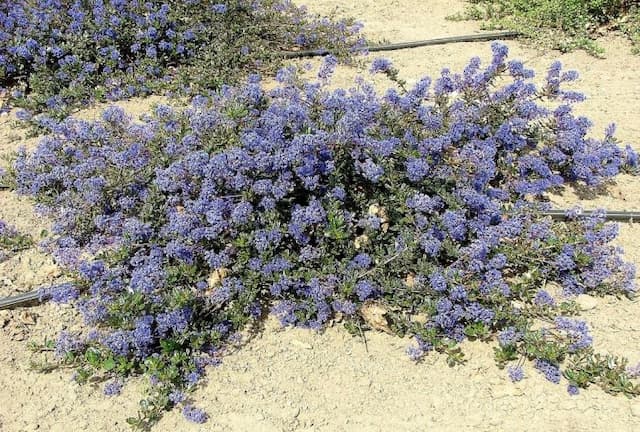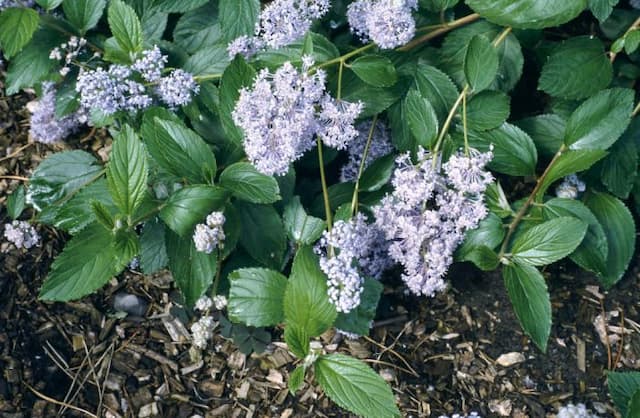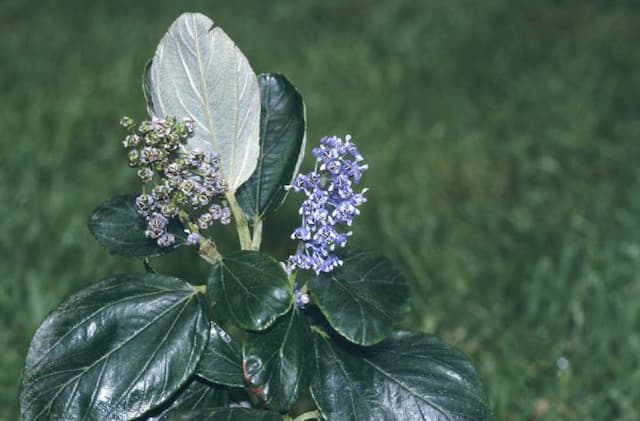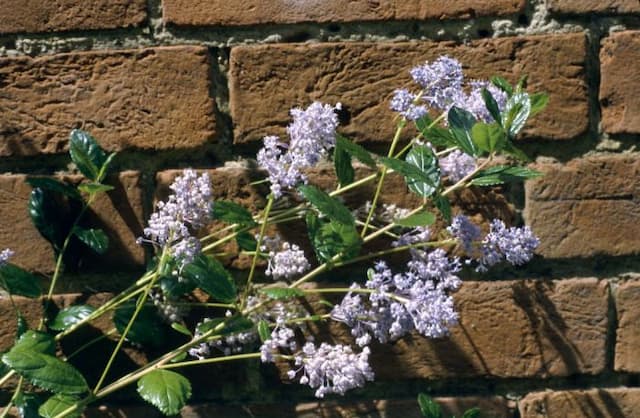Zanzibar Ceanothus Ceanothus 'Pershore Zanzibar' (PBR) (v)

ABOUT
The Ceanothus 'Pershore Zanzibar', commonly known as the California lilac 'Pershore Zanzibar', is a vibrant, eye-catching plant known for its decorative appearance. The foliage of this California lilac variant presents a striking variegation, with leaves featuring a blend of golden-yellow and lime-green, which can add a bright splash of color to any garden setting. The variegated leaves are typically small and oval to oblong in shape, creating a dense yet playful texture. During the blooming season, this cultivar produces clusters of tiny, intensely blue flowers that stand out against the bright foliage. These flowers typically grow in small, rounded clusters known as inflorescences, which become a focal point when they burst into color. The contrast between the blue flowers and the variegated leaves makes this plant especially attractive to both gardeners and pollinators like bees and butterflies. Overall, the California lilac 'Pershore Zanzibar' is visually appealing, with the striking combination of variegated leaves and vivid blue flowers offering a unique aesthetic appeal that can enhance diverse garden designs. Its colorful presence is valued for its ability to bring year-round interest to gardens, with the most dramatic displays occurring when in flower.
About this plant
 Names
NamesFamily
Rhamnaceae
Synonyms
Pershore Zanzibar California Lilac, Variegated Californian Lilac
Common names
Ceanothus 'Pershore Zanzibar' (PBR) (v)
 Toxicity
ToxicityTo humans
The plant commonly known as California lilac (Ceanothus 'Pershore Zanzibar' (PBR) (v)) is not typically considered toxic to humans. However, as with any plant, individual allergies or sensitivities can occur. If accidentally ingested in large quantities, mild stomach discomfort or nausea could potentially result, but severe toxicity is uncommon. It is generally advisable to avoid consuming parts of ornamental plants due to potential unknown individual reactions.
To pets
California lilac (Ceanothus 'Pershore Zanzibar' (PBR) (v)) is not widely recognized as a toxic plant to pets either. As with humans, pets may experience mild gastrointestinal upset if they consume large amounts of the plant due to the natural irritants plants can contain, but there is no significant toxin in the plant known to cause severe harm or poisoning to pets. Always monitor pets around plants and discourage them from chewing on any plant material to avoid potential issues.
 Characteristics
CharacteristicsLife cycle
Perennials
Foliage type
Evergreen
Color of leaves
Variegated
Flower color
Blue
Height
5 feet (1.5 meters)
Spread
6 feet (1.8 meters)
Plant type
Shrub
Hardiness zones
8
Native area
North America
Benefits
 General Benefits
General Benefits- Attractive Foliage - The Ceanothus 'Pershore Zanzibar' features striking variegated leaves that add color and visual interest to the landscape.
- Drought Tolerance - Once established, it is tolerant of drought, making it suitable for xeriscaping and water-wise gardens.
- Low Maintenance - This plant requires minimal pruning and upkeep once it has settled into its location.
- Wildlife Habitat - Its flowers attract beneficial insects such as bees and butterflies, supporting local biodiversity.
- Seasonal Interest - Produces vibrant blue flowers in late spring and summer that add a burst of color to gardens.
- Evergreen - As an evergreen shrub, it provides year-round interest and structure to garden designs.
 Medical Properties
Medical PropertiesThis plant is not used for medical purposes.
 Air-purifying Qualities
Air-purifying QualitiesThis plant is not specifically known for air purifying qualities.
 Other Uses
Other Uses- Create a natural dye: The leaves of the California Lilac can be used to produce a green dye for fabrics or textile projects.
- Artistic inspiration: Artists may use the California Lilac’s vibrant blue flowers as a subject for paintings, photography, or other visual art forms.
- Insectary plant: California Lilac can be included in gardens designed to attract beneficial insects, such as bees, butterflies, and predatory insects that feed on pests.
- Erosion control: With its dense root system, the California Lilac can be used on slopes or areas prone to erosion to help stabilize the soil.
- Education: Schools and educational programs can use the plant to teach students about native plants, pollination, and the importance of biodiversity.
- Privacy screens: With its dense foliage, California Lilac can be grown as a hedge or screen to increase privacy in garden spaces.
- Theme gardens: It can be used in theme gardens, such as a "blue" garden focused on plants with blue flowers or a California-native garden.
- Floral arrangements: Some people use the fresh or dried flowers of California Lilac in bouquets and floral displays.
- Fragrance gardens: The sweet scent of the California Lilac flowers can be included in fragrance gardens or sensory pathways.
- Wildlife habitat enhancement: The shrub can be planted to improve habitat for local wildlife, such as providing shelter for birds.
Interesting Facts
 Feng Shui
Feng ShuiThe California Lilac is not used in Feng Shui practice.
 Zodiac Sign Compitability
Zodiac Sign CompitabilityThe California Lilac is not used in astrology practice.
 Plant Symbolism
Plant Symbolism- Patriotism: The Californian lilac is often associated with a strong sense of regional pride and identity, particularly within California, where it's regarded as a state emblem.
- Resilience: The hardy nature of this shrub, which allows it to thrive in various conditions, makes it a symbol of resilience and adaptability.
- Harmony with Nature: As a drought-tolerant plant that's native to North America, the Californian lilac represents a harmonious relationship with the environment and sustainable gardening practices.
- Rebirth and Renewal: With its lush bloom in spring, the Californian lilac is often seen as a symbol of new beginnings and the refreshing energy of nature's renewal.
 Water
WaterCalifornia lilac should be watered deeply but infrequently to encourage a strong, deep root system. During its first growing season, water the plant weekly with about 1-2 gallons of water to help establish its roots. Once established, California lilac is quite drought tolerant and generally only needs additional water during extended periods of dryness. In the summer, if there is no rain, water every two to three weeks. Always allow the soil to dry out between watering sessions, as the plant does not tolerate soggy conditions.
 Light
LightCalifornia lilac thrives best in full sun conditions with at least six hours of direct sunlight each day to encourage prolific flowering and dense foliage growth. It should be placed in a spot where it is exposed to unfiltered, direct natural light, which is crucial for its overall health and blooming capabilities. However, in areas with very hot summers, some afternoon shade can be beneficial to prevent scorching of the leaves.
 Temperature
TemperatureCalifornia lilac prefers temperate conditions and can generally tolerate a range between 20°F for short periods and up to about 95°F. The ideal temperature range for robust growth and flowering is between 50°F and 75°F. It's vital to protect the plant from extreme cold snaps by mulching the base or providing some cover when temperatures dip towards the lower end of its tolerance.
 Pruning
PruningPrune California lilac to maintain its shape and remove any dead or damaged stems. Pruning should be done immediately after the blooming period in late spring or early summer, as the plant blooms on old wood. Remove up to one-third of the oldest stems to help rejuvenate the plant and encourage new growth. Light trimming can also be performed to keep the desired shape and size.
 Cleaning
CleaningAs needed
 Soil
SoilCalifornia Lilac (Ceanothus 'Pershore Zanzibar') thrives in well-draining soil with a pH ranging from slightly acidic to neutral (pH 6.0-7.0). A mix incorporating loam, sand, and compost or well-rotted organic matter is ideal, providing good drainage and fertility.
 Repotting
RepottingCalifornia Lilac should be repotted every 2-3 years to replenish the soil and accommodate root growth. It's best done in spring or early summer when the plant is actively growing.
 Humidity & Misting
Humidity & MistingCalifornia Lilac prefers moderate humidity levels but is quite adaptable and can tolerate the lower humidity found in most home environments without issue.
 Suitable locations
Suitable locationsIndoor
Ensure bright light, well-draining soil, and moderate humidity for indoor California Lilac.
Outdoor
Place in full sun, well-draining soil; shelter from harsh winds for outdoor California Lilac.
Hardiness zone
7-10 USDA
 Life cycle
Life cycleThe Ceanothus 'Pershore Zanzibar', commonly known as the Zanzibar California Lilac, begins its life cycle as a seed, dormant until it germinates, often requiring specific environmental triggers such as fire or scarification. Once germinated, the seedling emerges and establishes itself, gradually developing a root system and foliage. It enters a vegetative growth phase, characterized by rapid growth of leaves and stems, and in its maturity, it will develop woody stems and may reach up to 1.5 to 2 meters in height and spread. During its reproductive stage, which typically occurs in spring to early summer, the Zanzibar California Lilac produces clusters of vibrant blue or violet flowers that are attractive to bees and butterflies. After pollination, seeds develop and are eventually dispersed, allowing for the next generation to begin the life cycle anew. The plant, being a perennial, can live for several years with proper care, although it may require occasional pruning to maintain its shape and promote healthy growth.
 Propogation
PropogationPropogation time
Spring to Early Summer
The most popular method for propagating the Ceanothus 'Pershore Zanzibar', commonly known as Variegated California Lilac, is through semi-hardwood cuttings. This process typically takes place during mid-summer to early autumn. To do this, one must select healthy, non-flowering shoots that have begun to mature but are not yet fully woody. A cutting of about 4 to 6 inches (10 to 15 centimeters) is taken, with the lower leaves removed to expose a clean stem. The base of the cutting is then dipped into rooting hormone powder to encourage root growth and planted into a pot filled with a mixture of peat and perlite or a similar free-draining propagation medium. The pot should then be covered with a plastic bag or placed in a propagator to maintain high humidity, and kept in a warm place with indirect light until roots develop, which typically takes a few weeks to a couple of months.









